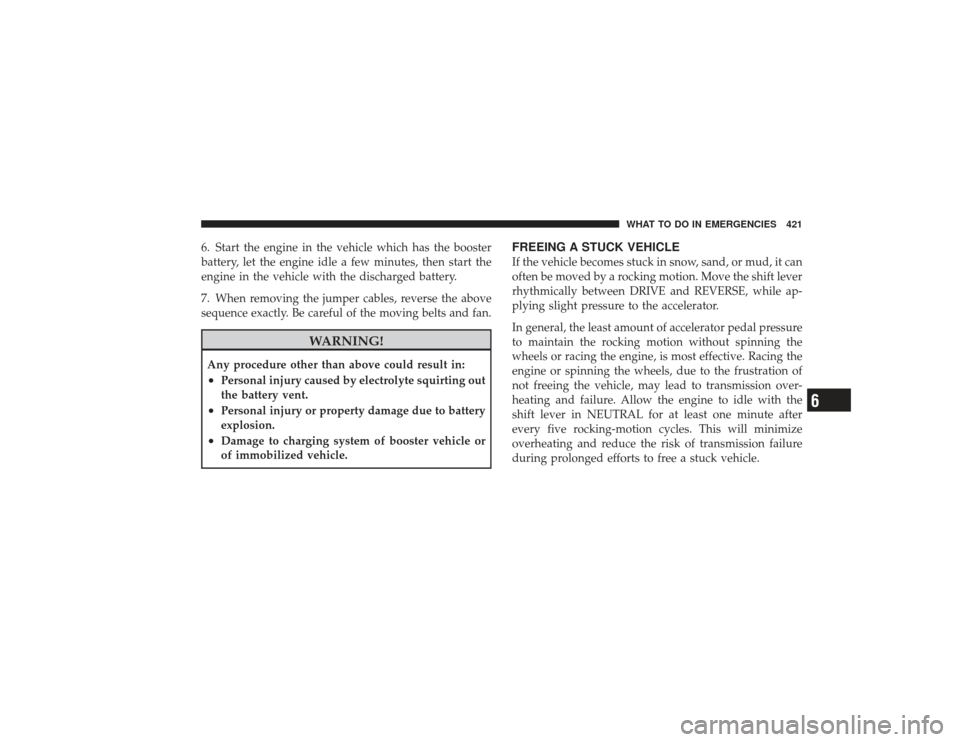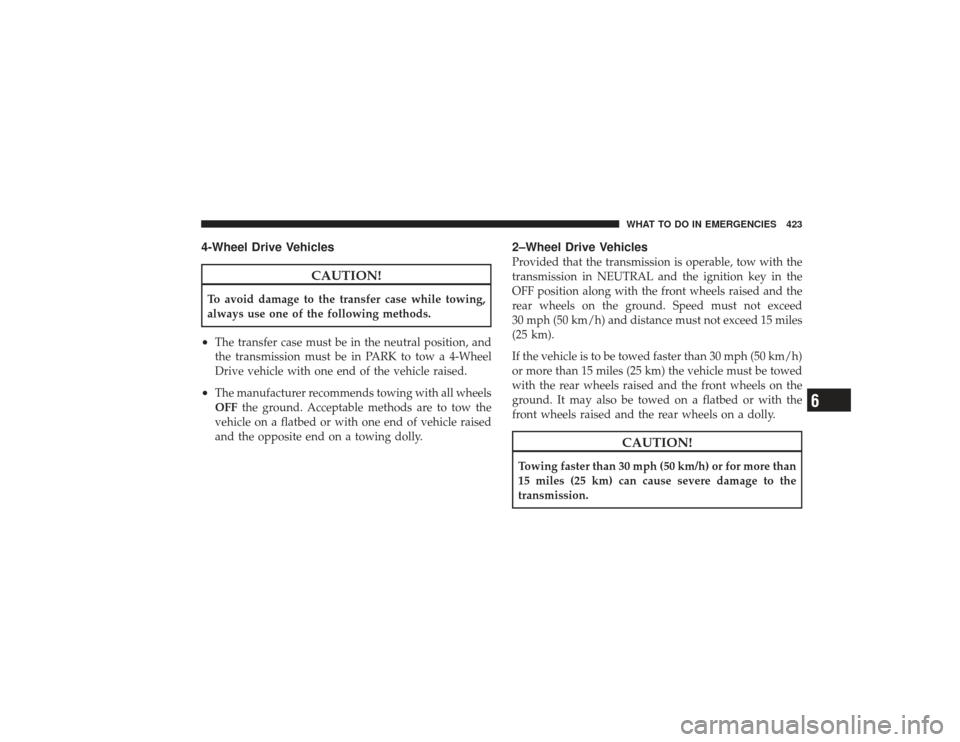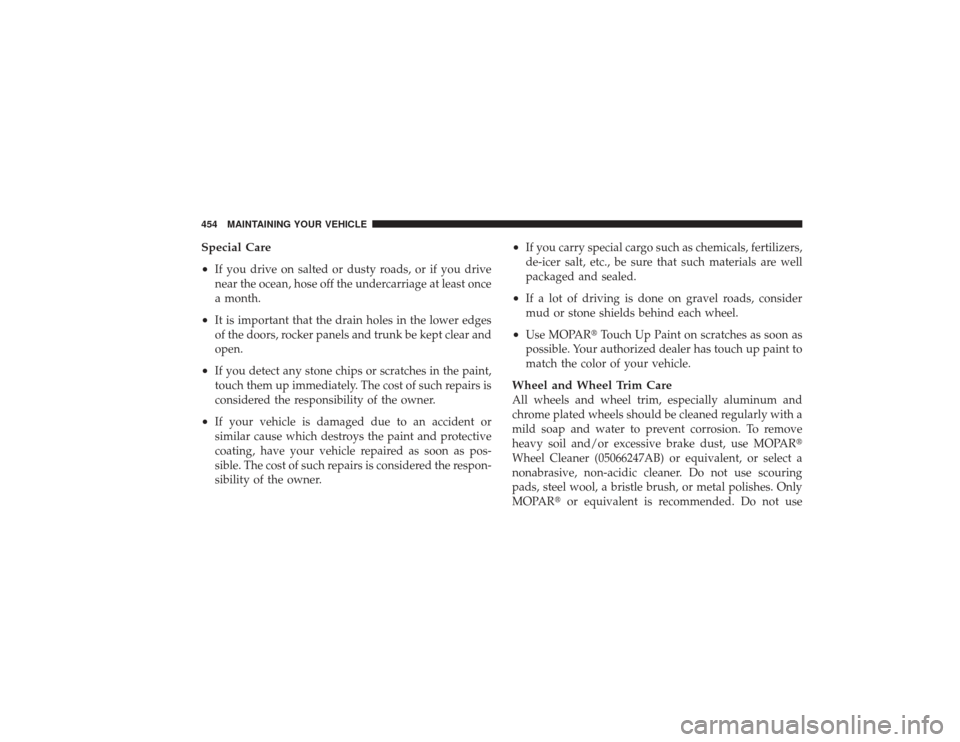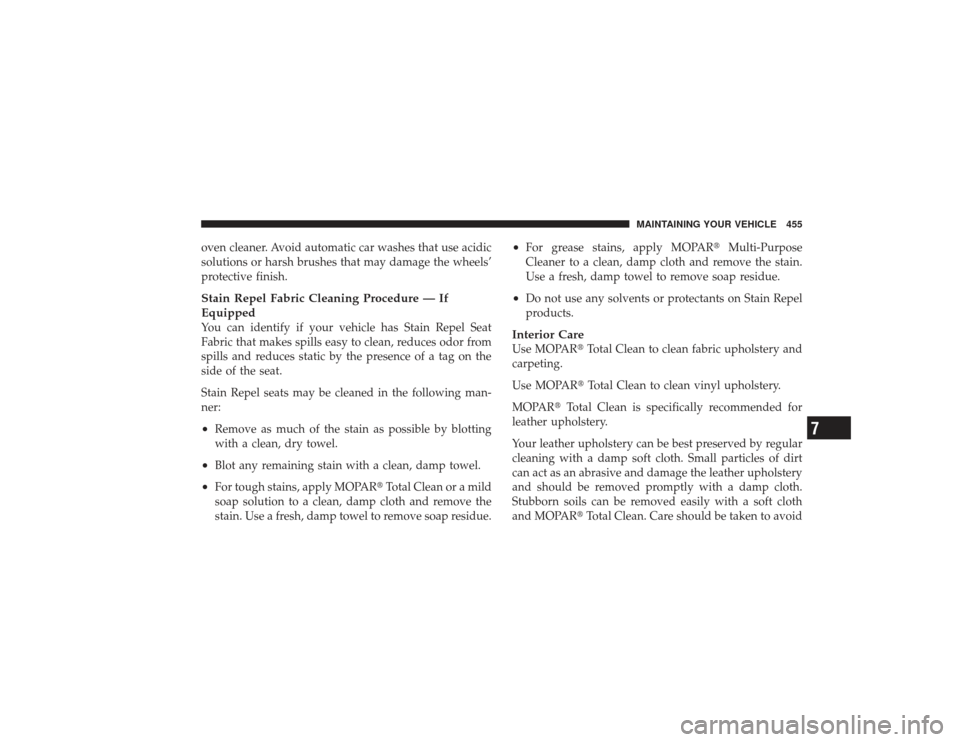Page 423 of 532

6. Start the engine in the vehicle which has the booster
battery, let the engine idle a few minutes, then start the
engine in the vehicle with the discharged battery.
7. When removing the jumper cables, reverse the above
sequence exactly. Be careful of the moving belts and fan.
WARNING!
Any procedure other than above could result in:•
Personal injury caused by electrolyte squirting out
the battery vent.
•
Personal injury or property damage due to battery
explosion.
•
Damage to charging system of booster vehicle or
of immobilized vehicle.
FREEING A STUCK VEHICLEIf the vehicle becomes stuck in snow, sand, or mud, it can
often be moved by a rocking motion. Move the shift lever
rhythmically between DRIVE and REVERSE, while ap-
plying slight pressure to the accelerator.
In general, the least amount of accelerator pedal pressure
to maintain the rocking motion without spinning the
wheels or racing the engine, is most effective. Racing the
engine or spinning the wheels, due to the frustration of
not freeing the vehicle, may lead to transmission over-
heating and failure. Allow the engine to idle with the
shift lever in NEUTRAL for at least one minute after
every five rocking-motion cycles. This will minimize
overheating and reduce the risk of transmission failure
during prolonged efforts to free a stuck vehicle.
WHAT TO DO IN EMERGENCIES 421
6
Page 425 of 532

4-Wheel Drive Vehicles
CAUTION!
To avoid damage to the transfer case while towing,
always use one of the following methods.•
The transfer case must be in the neutral position, and
the transmission must be in PARK to tow a 4-Wheel
Drive vehicle with one end of the vehicle raised.
•
The manufacturer recommends towing with all wheels
OFFthe ground. Acceptable methods are to tow the
vehicle on a flatbed or with one end of vehicle raised
and the opposite end on a towing dolly.
2–Wheel Drive VehiclesProvided that the transmission is operable, tow with the
transmission in NEUTRAL and the ignition key in the
OFF position along with the front wheels raised and the
rear wheels on the ground. Speed must not exceed
30 mph (50 km/h) and distance must not exceed 15 miles
(25 km).
If the vehicle is to be towed faster than 30 mph (50 km/h)
or more than 15 miles (25 km) the vehicle must be towed
with the rear wheels raised and the front wheels on the
ground. It may also be towed on a flatbed or with the
front wheels raised and the rear wheels on a dolly.
CAUTION!
Towing faster than 30 mph (50 km/h) or for more than
15 miles (25 km) can cause severe damage to the
transmission.
WHAT TO DO IN EMERGENCIES 423
6
Page 428 of 532

▫Cooling System .................... 441
▫ Brake System ...................... 447
▫ Rear Axle And 4X4 Front Driving Axle Fluid
Level ............................. 448
▫ Transfer Case ...................... 449
▫ Automatic Transmission .............. 449
▫ Appearance Care And Protection From
Corrosion .......................... 452
� Fuses ............................. 458
▫ Integrated Power Module ............. 458
� Vehicle Storage ...................... 463
� Replacement Light Bulbs ............... 464
� Bulb Replacement .................... 465
▫ Headlight (Halogen)/Front Park And Turn
Lights ............................ 465 ▫
Fog Lights ........................ 468
▫ Tail, Stop, Turn And Backup Lights ...... 469
▫ Center High-Mounted Stoplight (CHMSL)
With Cargo Light .................... 472
▫ Cab Top Clearance Lights — If Equipped . . 473
▫ Tailgate ID Lights (Dual Rear Wheels) —
If Equipped ........................ 475
▫ Rear Light Bar ID Marker
(Dual Rear Wheel) — If Equipped ........ 476
▫ Side Marker Lights (Dual Rear Wheels) . . . 477
� Fluids And Capacities ................. 478
� Fluids, Lubricants And Genuine Parts ...... 479
▫ Engine ........................... 479
▫ Chassis .......................... 480
426 MAINTAINING YOUR VEHICLE
Page 456 of 532

Special Care
•
If you drive on salted or dusty roads, or if you drive
near the ocean, hose off the undercarriage at least once
a month.
•
It is important that the drain holes in the lower edges
of the doors, rocker panels and trunk be kept clear and
open.
•
If you detect any stone chips or scratches in the paint,
touch them up immediately. The cost of such repairs is
considered the responsibility of the owner.
•
If your vehicle is damaged due to an accident or
similar cause which destroys the paint and protective
coating, have your vehicle repaired as soon as pos-
sible. The cost of such repairs is considered the respon-
sibility of the owner.
•
If you carry special cargo such as chemicals, fertilizers,
de-icer salt, etc., be sure that such materials are well
packaged and sealed.
•
If a lot of driving is done on gravel roads, consider
mud or stone shields behind each wheel.
•
Use MOPAR�Touch Up Paint on scratches as soon as
possible. Your authorized dealer has touch up paint to
match the color of your vehicle.
Wheel and Wheel Trim CareAll wheels and wheel trim, especially aluminum and
chrome plated wheels should be cleaned regularly with a
mild soap and water to prevent corrosion. To remove
heavy soil and/or excessive brake dust, use MOPAR �
Wheel Cleaner (05066247AB) or equivalent, or select a
nonabrasive, non-acidic cleaner. Do not use scouring
pads, steel wool, a bristle brush, or metal polishes. Only
MOPAR� or equivalent is recommended. Do not use
454 MAINTAINING YOUR VEHICLE
Page 457 of 532

oven cleaner. Avoid automatic car washes that use acidic
solutions or harsh brushes that may damage the wheels’
protective finish.Stain Repel Fabric Cleaning Procedure — If
EquippedYou can identify if your vehicle has Stain Repel Seat
Fabric that makes spills easy to clean, reduces odor from
spills and reduces static by the presence of a tag on the
side of the seat.
Stain Repel seats may be cleaned in the following man-
ner:•
Remove as much of the stain as possible by blotting
with a clean, dry towel.
•
Blot any remaining stain with a clean, damp towel.
•
For tough stains, apply MOPAR�Total Clean or a mild
soap solution to a clean, damp cloth and remove the
stain. Use a fresh, damp towel to remove soap residue.
•
For grease stains, apply MOPAR� Multi-Purpose
Cleaner to a clean, damp cloth and remove the stain.
Use a fresh, damp towel to remove soap residue.
•
Do not use any solvents or protectants on Stain Repel
products.
Interior CareUse MOPAR� Total Clean to clean fabric upholstery and
carpeting.
Use MOPAR� Total Clean to clean vinyl upholstery.
MOPAR� Total Clean is specifically recommended for
leather upholstery.
Your leather upholstery can be best preserved by regular
cleaning with a damp soft cloth. Small particles of dirt
can act as an abrasive and damage the leather upholstery
and should be removed promptly with a damp cloth.
Stubborn soils can be removed easily with a soft cloth
and MOPAR� Total Clean. Care should be taken to avoid
MAINTAINING YOUR VEHICLE 455
7
Page 466 of 532
REPLACEMENT LIGHT BULBSLIGHT BULBS — InteriorBulb No.
Overhead Console Lights ............... TS212-2
Dome Light ............................ 7679
NOTE: For lighted switches, see your authorized dealer
for replacement instructions.
All of the inside bulbs are brass or glass-wedge base.
Aluminum base bulbs are not approved. LIGHT BULBS — Exterior
Bulb No.
Backup ............................... 3057
Center High Mounted Stop Light ............. 912
Fog Light ........................... 9006LL
Headlight (Halogen) ...................... H13
Side Marker, Park & Turn Signal .........3157NAK
Rear License Plate Light .................... 168
Rear Cargo Light ......................... 912
Tail & Stop ............................ 3057
Cab Clearance Lights ...................... 168
Dual Rear Wheel Sidemarker Light ............ 168
Dual Rear Wheel Tailgate ID Lights (3) ......... 168464 MAINTAINING YOUR VEHICLE
Page 477 of 532
Tailgate ID Lights (Dual Rear Wheels) — If
Equipped1. Remove the two screws and housing and access the
bulb sockets from the rear.
MAINTAINING YOUR VEHICLE 475
7
Page 478 of 532
2. Turn the socket
1�4turn counterclockwise to access the
bulb.
3. Pull the bulb straight out from socket.
4. Reverse the procedure for installation of the bulbs and
housing.
Rear Light Bar ID Marker (Dual Rear Wheel) — If
Equipped1. Loosen the two screws and the housing to gain access
to the bulb sockets.
2. Turn the socket
1�4turn counterclockwise to access the
bulb.
476 MAINTAINING YOUR VEHICLE